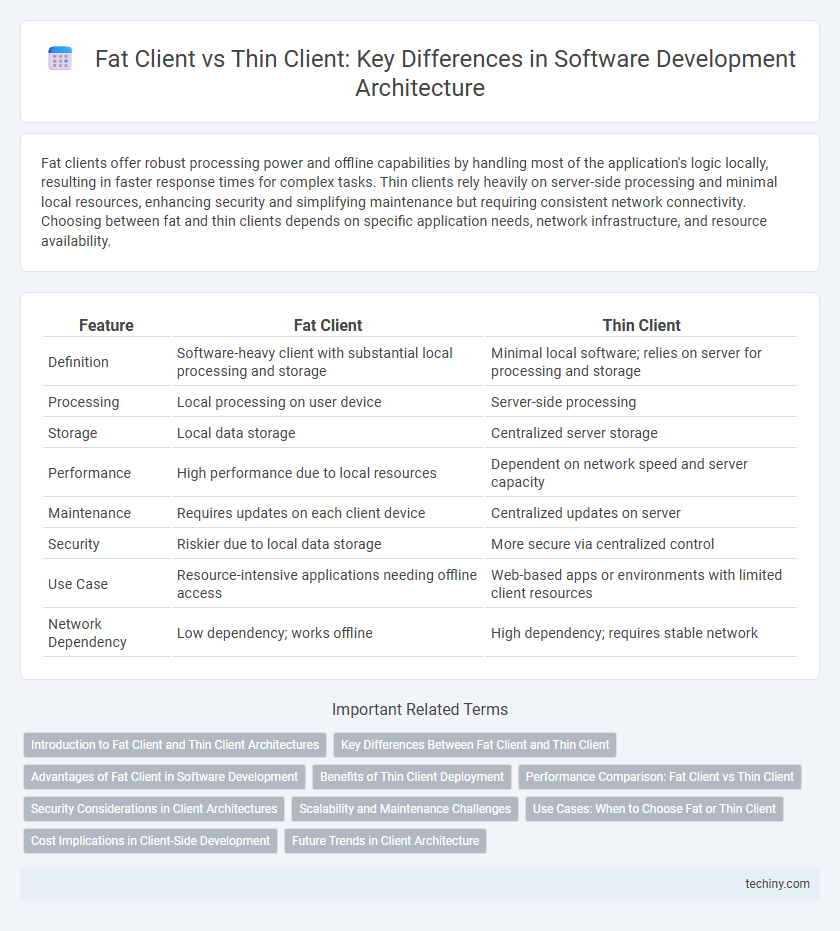Fat clients offer robust processing power and offline capabilities by handling most of the application's logic locally, resulting in faster response times for complex tasks. Thin clients rely heavily on server-side processing and minimal local resources, enhancing security and simplifying maintenance but requiring consistent network connectivity. Choosing between fat and thin clients depends on specific application needs, network infrastructure, and resource availability.
Table of Comparison
| Feature | Fat Client | Thin Client |
|---|---|---|
| Definition | Software-heavy client with substantial local processing and storage | Minimal local software; relies on server for processing and storage |
| Processing | Local processing on user device | Server-side processing |
| Storage | Local data storage | Centralized server storage |
| Performance | High performance due to local resources | Dependent on network speed and server capacity |
| Maintenance | Requires updates on each client device | Centralized updates on server |
| Security | Riskier due to local data storage | More secure via centralized control |
| Use Case | Resource-intensive applications needing offline access | Web-based apps or environments with limited client resources |
| Network Dependency | Low dependency; works offline | High dependency; requires stable network |
Introduction to Fat Client and Thin Client Architectures
Fat client architecture involves software where most processing tasks are performed on the client device, allowing for rich user interfaces and offline capabilities, typically requiring substantial local resources such as CPU, memory, and storage. Thin client architecture relies on centralized servers for processing and data storage, with the client device primarily acting as an interface to access remote applications, minimizing local resource needs and simplifying maintenance. Understanding the trade-offs between fat and thin clients is crucial for designing scalable, efficient software solutions that match organizational infrastructure and user needs.
Key Differences Between Fat Client and Thin Client
Fat clients process most data locally and have greater computing power, relying less on the server, which enables richer user interfaces and offline capabilities. Thin clients depend heavily on servers for processing and storage, requiring continuous network connectivity and resulting in lower hardware costs and simplified maintenance. The key differences include resource allocation, performance dependency, and user experience, where fat clients offer autonomy and thick functionality, while thin clients emphasize centralized control and scalability.
Advantages of Fat Client in Software Development
Fat clients enhance software development by enabling robust local processing power, which reduces server load and improves application responsiveness. They support offline functionality, allowing users to work without continuous server connectivity, which is crucial for productivity in unstable network environments. Fat clients also provide richer user interfaces and greater control over system resources, facilitating complex software applications that require intensive graphics or data processing.
Benefits of Thin Client Deployment
Thin client deployment significantly reduces hardware costs and simplifies maintenance by centralizing data processing on a server, enhancing security and control over sensitive information. This approach enables easier software updates and scalability, minimizing downtime and IT workload. Energy efficiency and reduced power consumption contribute to lower operational expenses and a smaller environmental footprint.
Performance Comparison: Fat Client vs Thin Client
Fat clients deliver superior performance by processing data locally, reducing reliance on network speed and server availability, which enhances responsiveness and user experience. Thin clients depend on server-side processing, making them vulnerable to latency and bandwidth limitations, potentially slowing down performance during high server loads. Choosing between fat and thin clients depends on application complexity, network infrastructure, and the need for offline functionality versus centralized control.
Security Considerations in Client Architectures
Fat client architectures store and process data locally, increasing risks of data theft and malware infections due to greater exposure to endpoint vulnerabilities. Thin clients rely on centralized servers for processing and data storage, enhancing security by minimizing sensitive information on user devices and simplifying patch management. Implementing robust encryption, user authentication, and network security protocols is critical for both architectures to protect against unauthorized access and data breaches.
Scalability and Maintenance Challenges
Fat clients demand significant local resources and complex updates, limiting scalability as each client requires individual maintenance and software installations. Thin clients centralize processing and updates on the server, enhancing scalability by simplifying maintenance and reducing hardware dependencies. However, thin clients rely heavily on network performance, which can impact user experience in large-scale deployments.
Use Cases: When to Choose Fat or Thin Client
Fat clients are ideal for applications requiring powerful local processing, offline capabilities, or rich user interfaces, such as graphic design software and complex data analysis tools. Thin clients excel in environments prioritizing centralized management, lower hardware costs, and enhanced security, commonly used in call centers, virtual desktop infrastructure (VDI), and cloud-based applications. Organizations should evaluate bandwidth availability, processing needs, and maintenance resources to determine the optimal client architecture for their specific use case.
Cost Implications in Client-Side Development
Fat client architecture demands higher upfront investments in powerful hardware and extensive software maintenance, increasing overall client-side development costs. Thin clients reduce expenses by relying on centralized servers for processing, minimizing the need for costly local resources and frequent updates. Organizations must consider the trade-off between initial infrastructure costs and ongoing operational expenses when choosing between fat and thin client models.
Future Trends in Client Architecture
Future trends in client architecture emphasize the rise of hybrid models combining the robustness of fat clients with the efficiency of thin clients, leveraging cloud computing and edge computing advancements. Increasing adoption of progressive web apps (PWAs) and WebAssembly enables rich user experiences with minimal local resource consumption. Enhanced cybersecurity measures and AI-driven optimization will further shape client designs, balancing performance with scalability and security in distributed systems.
Fat Client vs Thin Client Infographic

 techiny.com
techiny.com